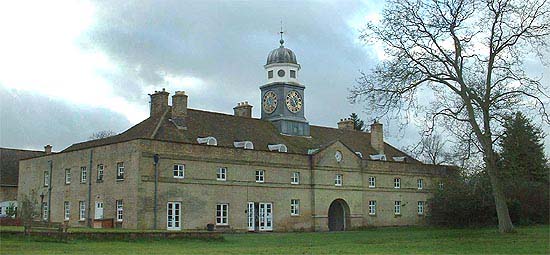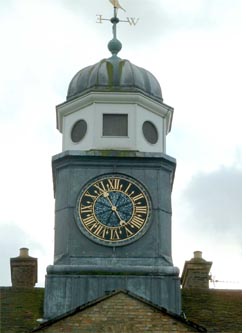Wandering About Wandlebury
by Ian Sanderson
Wandlebury is about 4 miles south east of Cambridge, an easy drive with plenty of parking space when you get there. The entrance is midway down the only stretch of dual carriageway road between Cambridge and Linton (A1307). The site is a wooded knoll overlooking the valley of the River Cam in a patch of low chalk hills called the Gog Magogs. It looks like, and is, a country park with patches of short grass scattered in between wooded areas, interlaced with well maintained paths and tracks. In the center lies an old stable block with a fine cupola tower clock, the brick wall of a walled garden area and an old pond. Below the clock tower, in the archway, is the grave of the 'Godolphin Arabian', the most famous of the Arabian stallions brought to England, and the ancestor of many of today's thoroughbred racehorses, which died here, aged 29 years, in 1753.

The first clue to the real history of Wandlebury is the bridge over the moat, no gatehouse or ruins that you would expect from a castle, just a simple, short, brick bridge. Walking around the moat in a shady tunnel of tree topped steep banks you will notice that it is perfectly circular and quite big (about 1000 foot diameter or over half a mile round the moat). It is in fact an Iron Age hill fort enclosure, probably settled around the 5th Century BC and fortified with 2 ring ditches around 400 BC. It may have been built by the Iceni to defend against the other neighbouring tribe, the Catuvellauni prior to the Roman invasion. The most noticeable Roman feature, at the edge of the park area, is the Via Devana, a Roman road running from Colchester to Godmanchester with patches of its original surface still intact. Almost nothing is known of the site itself between the Romans and the Middle Ages, although Roman finds have been unearthed there and Anglo Saxons documents refer to it as. Wendlesbiri. In the early Middle Ages it was used as a meeting place for the 'Hundreds' Court.
 In 1685 James II had a racing stable built inside the hillfort. In the 1730s this was acquired by Francis, 2nd Earl of Godolphin, who built a substantial house and garden and expanded the racing stable. Unfortunately the work obliterated much of the embankment. In 1685 James II had a racing stable built inside the hillfort. In the 1730s this was acquired by Francis, 2nd Earl of Godolphin, who built a substantial house and garden and expanded the racing stable. Unfortunately the work obliterated much of the embankment.
Wandlebury is rich in legend, most relating to the gods Gog and Magog, after whom the local hills are named. Other legends, such as that related by Gervase of Tilbury in 1219, tell that Wandlebury was once ruled by a dark night-rider who apparently no mortal could defeat. Anyone brave enough to test his prowess had to ride up into the camp on a moonlit night and cry 'knight to knight, come forth!' The warrior would appear on horseback, ready to fight until he or his opponent was dismounted.
More recently in 1955 the archaeologist TC Lethbridge decided to explore historical references to chalk cut figures on the sides of the mound. He did this by finding soft patches in the ground with a heavy bar and some surprising shapes emerged. These included a three-breasted female astride two horses pulling a chariot, a gigantic warrior, and a sun-god, all in a Celtic style. Lethbridge suggested that they were cut around 200 BC. He even published some new theories on the basis of Celtic Art, in a book 'Gogmagog: the buried gods' published in 1957. None of these figures are visible now, although they can be conjured up in the mind from the traces of his explorations still visible on the slope directly below the bridge at the entrance. The more conventional view today is that he might have been letting his imagination get the better of him! Crop circles have also been reported nearby.
More Information:
We regret that we no longer have the resources to maintain up-to-date links and/or hours and pricing details for the various sites and attractions listed on this website. For more information about the location(s) listed above, please use your favorite search engine or visit Wikipedia.
Ian Sanderson started out as an industrial pharmacist and now provides medical writing
services to the pharmaceutical industry to make ends meet. Later on he took
a short course in Landscape Archaeology and got hooked. With a small amateur
group he now spends most of his spare time doing resistivity testing, which
looks pretty much like wandering over muddy fields with a zimmer frame, to
find out what's under the ground on archaeological sites. The group recently
published a book on their work around Thriplow in Cambridgeshire.
Article and photos © 2005 Ian Sanderson
|
